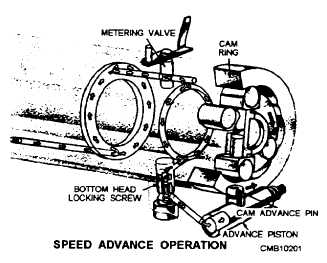(fig. 5-18). The rising fuel pressure from the transfer pump increases the flow to the power side of the advance piston. This flow from the transfer pump passes through a cut on the metering valve, through a passage in the hydraulic head, and then by the check valve in the drilled bottom head locking screw. The check valve provides a hydraulic lock, preventing the cam from retarding during injection. Fuel is directed by a passage in the advance housing and plug to the pressure side of the advance piston. The piston moves the cam counterclockwise (opposite to the direction of the pump rotation). The spring-loaded side of the piston balances the force of the power side of the piston and limits the maximum movement of the cam. Therefore, with increasing speed, the cam is advanced and, with decreasing speed, it is retarded.
We know that a small amount of fuel under pressure is vented into the governor linkage compartment. Flow into this area is controlled by a small vent wire that controls the volume of fuel returning to the fuel tank, thereby avoiding any undue fuel pressure loss. The vent passage is located behind the metering valve bore and leads to the governor compartment by a short vertical passage. The vent wire assembly is available in several sizes to control the amount of vented fuel being returned to the tank. The vent wire should NOT be tampered with, as it can be altered only by removing the governor cover. The correct wire size would be installed when the pump assembly is being flow-tested on a pump calibration stand.
NOTE
For information concerning removal, installation, and servicing the injection pump, always refer to the manufacturer's service manual.
Injection Pump Accessories
The DB2 injection pump can be used on a variety of applications; therefore, it is available with several options as required. The options are as follows:
The flexible governor drive is a retaining ring that serves as a cushion between the governor weight retainer and the weight retainer hub. Any torsional vibrations that may be transmitted to the pump area are absorbed in the flexible ring, therefore reducing wear of pump parts and allowing more positive governor control.

Figure 5-18. - Speed advance operation.
The electrical shutoff (fig. 5-19) is available as either an energized to run (ETR) or energized to shut off (ETSO) model. In either case it will control the run and stop functions of the engine by positively stopping fuel flow to the pump plungers, thereby preventing fuel injection.
The torque screw, used on DB2 pumps, allows a tailored maximum torque curve for a particular engine application. This feature is commonly referred to as torque backup, since the engine torque will generally increase toward the preselected and adjusted point as engine rpm decreases. The three factors that affect this torque are the metering valve opening area, the time allowed for fuel charging, and the transfer pump pressure curve.
Turning in the torque screw moves the fuel- metering valve toward its closed position. The torque screw controls the amount of fuel delivered at full-load governor speed.

Figure 5-19. - Electrical shutoff.
Continue Reading